
List of lunar probes
Encyclopedia
This is a list of space probes that have flown by, impacted, or landed on the Moon
for the purpose of lunar exploration
, as well as probes launched toward the Moon that failed to reach their target. Confirmed future probes are included, but missions that are still at the concept stage, or which never progressed beyond the concept stage, are not.
The list does not include the manned Apollo
missions.
Moon
The Moon is Earth's only known natural satellite,There are a number of near-Earth asteroids including 3753 Cruithne that are co-orbital with Earth: their orbits bring them close to Earth for periods of time but then alter in the long term . These are quasi-satellites and not true moons. For more...
for the purpose of lunar exploration
Exploration of the Moon
The physical exploration of the Moon began when Luna 2, a space probe launched by the Soviet Union, made an impact on the surface of the Moon on September 14, 1959. Prior to that the only available means of exploration had been observation. The invention of the optical telescope brought about the...
, as well as probes launched toward the Moon that failed to reach their target. Confirmed future probes are included, but missions that are still at the concept stage, or which never progressed beyond the concept stage, are not.
The list does not include the manned Apollo
Project Apollo
The Apollo program was the spaceflight effort carried out by the United States' National Aeronautics and Space Administration , that landed the first humans on Earth's Moon. Conceived during the Presidency of Dwight D. Eisenhower, Apollo began in earnest after President John F...
missions.
Key
Colour key:| – Mission or flyby completed successfully (or partially successfully) | – Failed or cancelled mission | ||
| – Mission en route or in progress (including mission extensions) | – Planned mission |
- † means "tentatively identified", as classified by NASA http://nssdc.gsfc.nasa.gov/planetary/tent_launch.html. These are Cold War-era Soviet missions, mostly failures, about which few or no details have been officially released. The information given may be speculative.
- Date is the date of:
- closest encounter (flybys)
- impact (impactors)
- orbital insertion to end of mission, whether planned or premature (orbiters)
- landing to end of mission, whether planned or premature (landers)
- launch (missions that never got underway due to failure at or soon after launch)
- In cases which do not fit any of the above, the event to which the date refers is stated. Note that as a result of this scheme missions are not always listed in order of launch.
- Under Status:
- success means that the mission fulfilled its primary goals. In the case of flybys (such as gravity assists) that are incidental to the main mission, "success" indicates the successful completion of the flyby, not necessarily that of the main mission.
- partial success means that the mission fulfilled some but not all of its primary goals
- failure means that the mission did not fulfil any of its primary goals
- Other entries are self-explanatory.
1958
| Spacecraft | Organization | Date | Type | Status | Notes | Image | Ref | |
|---|---|---|---|---|---|---|---|---|
| Pioneer 0 Pioneer 0 Pioneer 0 was a failed United States space probe that was designed to go into orbit around the Moon, carrying a television camera, a micrometeorite detector and a magnetometer, as part of the first International Geophysical Year science payload... |
 DOD DODUnited States Department of Defense The United States Department of Defense is the U.S... |
17 August 1958 | orbiter | failure | first attempted launch beyond Earth orbit; launch vehicle failure; maximum altitude 16 km |  |
http://nssdc.gsfc.nasa.gov/nmc/spacecraftDisplay.do?id=ABLE1 | |
| Luna E-1 No.1 |  USSR USSR |
23 September 1958 | impactor | failure | launch vehicle failure |  |
http://www.astronautix.com/craft/lunae1.htm | |
| Pioneer 1 Pioneer 1 On October 11, 1958, Pioneer 1 became the first spacecraft launched by NASA, the newly formed space agency of the United States. The flight was the second and most successful of the three Thor-Able space probes.- Spacecraft design :... |
 NASA NASANASA The National Aeronautics and Space Administration is the agency of the United States government that is responsible for the nation's civilian space program and for aeronautics and aerospace research... /  DOD DODUnited States Department of Defense The United States Department of Defense is the U.S... |
11 October 1958 | orbiter | failure | second stage premature shutdown; maximum altitude 113,800 km; some data returned |  |
http://nssdc.gsfc.nasa.gov/nmc/spacecraftDisplay.do?id=1958-007A | |
| Luna E-1 No.2 |  USSR USSR |
12 October 1958 | impactor | failure | launch vehicle failure |  |
http://www.astronautix.com/craft/lunae1.htm | |
| Pioneer 2 Pioneer 2 Pioneer 2 was the last of the three project Able space probes designed to probe lunar and cislunar space. Shortly after launch at 07:30:00 UTC on November 8, 1958, the third stage of the launch vehicle separated but failed to ignite, and Pioneer 2 did not achieve its intended lunar orbit... |
 NASA NASANASA The National Aeronautics and Space Administration is the agency of the United States government that is responsible for the nation's civilian space program and for aeronautics and aerospace research... /  STL STL |
8 November 1958 | orbiter | failure | third stage failure; maximum altitude 1,550 km; some data returned |  |
http://nssdc.gsfc.nasa.gov/nmc/spacecraftDisplay.do?id=PION2 | |
| Luna E-1 No.3 |  USSR USSR |
4 December 1958 | impactor | failure | launch vehicle failure |  |
http://www.astronautix.com/craft/lunae1.htm | |
| Pioneer 3 Pioneer 3 Pioneer 3 was a spin stabilized spacecraft launched at 05:45:12 UTC on 6 December 1958 by the U.S. Army Ballistic Missile Agency in conjunction with the National Aeronautics and Space Administration... |
 NASA NASANASA The National Aeronautics and Space Administration is the agency of the United States government that is responsible for the nation's civilian space program and for aeronautics and aerospace research... /  DOD DODUnited States Department of Defense The United States Department of Defense is the U.S... |
6 December 1958 | flyby | failure | fuel depletion; maximum altitude 102,360 km; some data returned |  |
http://nssdc.gsfc.nasa.gov/nmc/spacecraftDisplay.do?id=1958-008A | |
1959
| Spacecraft | Organization | Date | Type | Status | Notes | Image | Ref | |
|---|---|---|---|---|---|---|---|---|
| Luna 1 Luna 1 Luna 1 , first known as First Cosmic Ship, then known as Mechta was the first spacecraft to reach the vicinity of the Moon and the first of the Luna program of Soviet automatic interplanetary stations successfully launched in the direction of the Moon.While traveling through the outer Van Allen... |
 USSR USSR |
4 January 1959 | flyby | partial success | first spacecraft in the vicinity of the Moon (flew within 5,995 km, but probably an intended impactor) |  |
http://nssdc.gsfc.nasa.gov/nmc/spacecraftDisplay.do?id=1959-012A | |
| Luna E-1A No.1 |  USSR USSR |
18 June 1959 | impactor | failure | failed to reach Earth orbit | http://space.skyrocket.de/doc_sdat/luna_e1a.htm | ||
| Pioneer 4 Pioneer 4 Pioneer 4 was a spin-stabilized spacecraft launched as part of the Pioneer program on a lunar flyby trajectory and into a heliocentric orbit making it the first U.S. probe to escape from the Earth's gravity. It carried a payload similar to Pioneer 3: a lunar radiation environment experiment using a... |
 NASA NASANASA The National Aeronautics and Space Administration is the agency of the United States government that is responsible for the nation's civilian space program and for aeronautics and aerospace research... /  DOD DODUnited States Department of Defense The United States Department of Defense is the U.S... |
4 March 1959 | flyby | partial success | achieved distant flyby; first US United States The United States of America is a federal constitutional republic comprising fifty states and a federal district... probe to enter solar orbit |
 |
http://nssdc.gsfc.nasa.gov/nmc/spacecraftDisplay.do?id=1959-013A | |
| Luna 2 Luna 2 Luna 2 was the second of the Soviet Union's Luna programme spacecraft launched to the Moon. It was the first spacecraft to reach the surface of the Moon... |
 USSR USSR |
14 September 1959 | impactor | success | first impact on Moon | http://nssdc.gsfc.nasa.gov/nmc/spacecraftDisplay.do?id=1959-014A | ||
| Pioneer P-1 Pioneer P-1 Pioneer P-1 was a failed mission in the Pioneer program. The spacecraft was a 1 meter diameter sphere, with a propulsion module. It was launched on September 24, 1959 on an Atlas-C Able launcher. It was to carry a TV camera and a magnetic field sensor. It was to be spin-stabilized, and was known as... |
 NASA NASANASA The National Aeronautics and Space Administration is the agency of the United States government that is responsible for the nation's civilian space program and for aeronautics and aerospace research... |
24 September 1959? | orbiter? | failure | designation sometimes given to a failed launch or launchpad explosion during testing; conflicting information between sources | 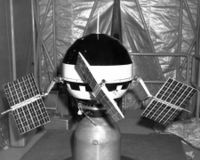 |
||
| Luna 3 Luna 3 The Soviet space probe Luna 3 of 1959 was the third space probe to be sent to the neighborhood of the Moon, and this mission was an early feat in the spaceborne exploration of outer space... |
 USSR USSR |
6 October 1959 | flyby | success | first images from the lunar farside | http://nssdc.gsfc.nasa.gov/nmc/spacecraftDisplay.do?id=1959-008A | ||
| Pioneer P-3 Pioneer P-3 Pioneer P-3 was intended to be a lunar orbiter probe, but the mission failed shortly after launch. The objectives were to place a highly instrumented probe in lunar orbit, to investigate the environment between the Earth and Moon, and to develop technology for controlling and maneuvering... |
 NASA NASANASA The National Aeronautics and Space Administration is the agency of the United States government that is responsible for the nation's civilian space program and for aeronautics and aerospace research... |
26 November 1959 | orbiter | failure | disintegrated shortly after launch |  |
http://nssdc.gsfc.nasa.gov/nmc/spacecraftDisplay.do?id=PIONX | |
1960
| Spacecraft | Organization | Date | Type | Status | Notes | Image | Ref | |
|---|---|---|---|---|---|---|---|---|
| Luna 1960A Luna 1960A Luna E-3 No.1, sometimes identified by NASA as Luna 1960A, was a Soviet spacecraft which was lost in a launch failure in 1960. It was a Luna E-3 spacecraft, the first of two to be launched, both of which were lost in launch failures. It was intended to fly around the moon on a circumlunar... † |
 USSR USSR |
15 April 1960 | flyby | failure | failed to attain correct trajectory | http://nssdc.gsfc.nasa.gov/planetary/tent_launch.html | ||
| Luna 1960B Luna 1960B Luna E-3 No.2, sometimes identified by NASA as Luna 1960B, was a Soviet spacecraft which was lost in a launch failure in 1960. It was a Luna E-3 spacecraft, the second of two to be launched, both of which were lost in launch failures. It was intended to fly around the moon on a circumlunar... † |
 USSR USSR |
16 April 1960 | flyby | failure | launch vehicle failure | http://nssdc.gsfc.nasa.gov/planetary/tent_launch.html | ||
| Pioneer P-30 Pioneer P-30 Pioneer P-30 was intended to be a lunar orbiter probe, but the mission failed shortly after launch on September 25, 1960. The objectives were to place a highly instrumented probe in lunar orbit, to investigate the environment between the Earth and Moon, and to develop technology for controlling... |
 NASA NASANASA The National Aeronautics and Space Administration is the agency of the United States government that is responsible for the nation's civilian space program and for aeronautics and aerospace research... |
25 September 1960 | orbiter | failure | second stage failure; failed to reach Earth orbit |  |
http://nssdc.gsfc.nasa.gov/nmc/spacecraftDisplay.do?id=PIONY | |
| Pioneer P-31 Pioneer P-31 Pioneer P-31 was intended to be a lunar orbiter probe, but the mission failed shortly after launch. The objectives were to place a highly instrumented probe in lunar orbit, to investigate the environment between the Earth and Moon, and to develop technology for controlling and maneuvering... |
 NASA NASANASA The National Aeronautics and Space Administration is the agency of the United States government that is responsible for the nation's civilian space program and for aeronautics and aerospace research... |
15 December 1960 | orbiter | failure | first stage failure |  |
http://nssdc.gsfc.nasa.gov/nmc/spacecraftDisplay.do?id=PIONZ | |
1962–1963
| Spacecraft | Organization | Date | Type | Status | Notes | Image | Ref | |
|---|---|---|---|---|---|---|---|---|
| Ranger 3 Ranger 3 Ranger 3 is a spacecraft of the Ranger program that was launched to study the Moon on January 26, 1962. The space probe was designed to transmit pictures of the lunar surface to Earth stations during a period of 10 minutes of flight prior to impacting on the Moon, to rough-land a seismometer... |
 NASA NASANASA The National Aeronautics and Space Administration is the agency of the United States government that is responsible for the nation's civilian space program and for aeronautics and aerospace research... |
28 January 1962 | impactor | failure | missed target | 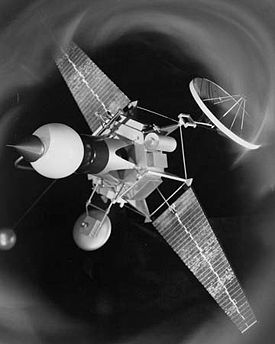 |
http://nssdc.gsfc.nasa.gov/nmc/spacecraftDisplay.do?id=1962-001A | |
| Ranger 4 Ranger 4 Ranger 4 was a spacecraft of the Ranger program designed to transmit pictures of the lunar surface to Earth stations during a period of 10 minutes of flight prior to crashing upon the Moon, to rough-land a seismometer capsule on the Moon, to collect gamma-ray data in flight, to study radar... |
 NASA NASANASA The National Aeronautics and Space Administration is the agency of the United States government that is responsible for the nation's civilian space program and for aeronautics and aerospace research... |
26 April 1962 | impactor | failure | hit the lunar farside; no data returned | 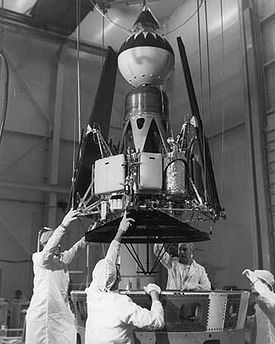 |
http://nssdc.gsfc.nasa.gov/nmc/spacecraftDisplay.do?id=1962-012A | |
| Ranger 5 Ranger 5 Ranger 5 was a spacecraft of the Ranger program designed to transmit pictures of the lunar surface to Earth stations during a period of 10 minutes of flight prior to impacting on the Moon, to rough-land a seismometer capsule on the Moon, to collect gamma-ray data in flight, to study radar... |
 NASA NASANASA The National Aeronautics and Space Administration is the agency of the United States government that is responsible for the nation's civilian space program and for aeronautics and aerospace research... |
21 October 1962 | impactor | failure | power failure, missed target | 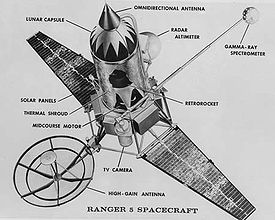 |
http://nssdc.gsfc.nasa.gov/nmc/spacecraftDisplay.do?id=1962-055A | |
| Sputnik 25 Sputnik 25 Luna E-6 No.2, also identified as No.1, and sometimes known in the West as Sputnik 25, was a Soviet spacecraft which launched in 1963, but was placed into a useless orbit due to a problem with the upper stage of the rocket that launched it... |
 USSR USSR |
5 January 1963 | lander | failure | failed to escape Earth orbit |  |
http://nssdc.gsfc.nasa.gov/nmc/spacecraftDisplay.do?id=1963-001A | |
| Luna 1963B Luna 1963B Luna E-6 No.3, also identified as No.2 and sometimes by NASA as Luna 1963B, was a Soviet spacecraft which was lost in a launch failure in 1963. It was a Luna E-6 spacecraft, the second of twelve to be launched, and the second consecutive launch failure... † |
 USSR USSR |
2 February 1963 | lander? | failure | failed to reach Earth orbit |  |
http://nssdc.gsfc.nasa.gov/planetary/tent_launch.html | |
| Luna 4 Luna 4 Luna 4 was the USSR's first successful spacecraft of their "second generation" Luna program. The spacecraft, rather than being sent on a straight trajectory toward the Moon, was placed first in a low Earth orbit and then the rocket stage reignited to send it on a curving path towards the... |
 USSR USSR |
5 April 1963 | lander? | failure | missed target, became Earth satellite |  |
http://nssdc.gsfc.nasa.gov/nmc/spacecraftDisplay.do?id=1963-008B | |
1964
| Spacecraft | Organization | Date | Type | Status | Notes | Image | Ref | |
|---|---|---|---|---|---|---|---|---|
| Ranger 6 Ranger 6 Ranger 6 was designed to achieve a lunar impact trajectory and to transmit high-resolution photographs of the lunar surface during the final minutes of flight up to impact. The spacecraft carried six television vidicon cameras, 2 wide angle and 4 narrow angle to accomplish these objectives... |
 NASA NASANASA The National Aeronautics and Space Administration is the agency of the United States government that is responsible for the nation's civilian space program and for aeronautics and aerospace research... |
2 February 1964 | impactor | partial success | impacted, but no pictures returned due to power failure |  |
http://nssdc.gsfc.nasa.gov/nmc/spacecraftDisplay.do?id=1964-007A | |
| Luna 1964A Luna 1964A Luna E-6 No.6, sometimes identified by NASA as Luna 1964A, was a Soviet spacecraft which was lost in a launch failure in 1964. It was a Luna E-6 spacecraft, the fourth of twelve to be launched, It was intended to be the first spacecraft to perform a soft landing on the Moon, a goal which would... † |
 USSR USSR |
21 March 1964 | lander | failure | failed to reach Earth orbit |  |
http://nssdc.gsfc.nasa.gov/planetary/tent_launch.html | |
| Luna 1964B Luna 1964B Luna E-6 No.5, sometimes identified by NASA as Luna 1964B, was a Soviet spacecraft which was lost in a launch failure in 1964. It was a Luna E-6 spacecraft, the fifth of twelve to be launched, It was intended to be the first spacecraft to perform a soft landing on the Moon, a goal which would... † |
 USSR USSR |
20 April 1964 | lander | failure | failed to reach Earth orbit |  |
http://nssdc.gsfc.nasa.gov/planetary/tent_launch.html | |
| Ranger 7 Ranger 7 Ranger 7 was the first US space probe to successfully transmit close images of the lunar surface back to Earth. It was also the first completely successful flight of the Ranger program. Launched on 28 July 1964, Ranger 7 was designed to achieve a lunar impact trajectory and to transmit... |
 NASA NASANASA The National Aeronautics and Space Administration is the agency of the United States government that is responsible for the nation's civilian space program and for aeronautics and aerospace research... |
31 July 1964 | impactor | success | returned pictures up until impact |  |
http://nssdc.gsfc.nasa.gov/nmc/spacecraftDisplay.do?id=1964-041A | |
1965
| Spacecraft | Organization | Date | Type | Status | Notes | Image | Ref | |
|---|---|---|---|---|---|---|---|---|
| Ranger 8 Ranger 8 Ranger 8 was a spacecraft designed to achieve a lunar impact trajectory and to transmit high-resolution photographs of the lunar surface during the final minutes of flight up to impact. The spacecraft carried six television vidicon cameras, two wide angle and four narrow angle to accomplish these... |
 NASA NASANASA The National Aeronautics and Space Administration is the agency of the United States government that is responsible for the nation's civilian space program and for aeronautics and aerospace research... |
20 February 1965 | impactor | success | returned pictures up until impact |  |
http://nssdc.gsfc.nasa.gov/nmc/spacecraftDisplay.do?id=1965-010A | |
| Cosmos 60 Cosmos 60 Kosmos 60 was an E-6 series probe, launched by the Soviet Union on March 12, 1965. It was the sixth attempt at a lunar soft-landing mission, with a design similar to that of Luna 4... |
 USSR USSR |
12 March 1965 | lander | failure | failed to leave Earth orbit |  |
http://nssdc.gsfc.nasa.gov/nmc/spacecraftDisplay.do?id=1965-018A | |
| Ranger 9 Ranger 9 Ranger 9 was designed to achieve a lunar impact trajectory and to transmit high-resolution photographs of the lunar surface during the final minutes of flight up to impact. The spacecraft carried six television vidicon cameras, 2 wide angle and 4 narrow angle to accomplish these objectives... |
 NASA NASANASA The National Aeronautics and Space Administration is the agency of the United States government that is responsible for the nation's civilian space program and for aeronautics and aerospace research... |
24 March 1965 | impactor | success | TV broadcast of live pictures up until impact |  |
http://nssdc.gsfc.nasa.gov/nmc/spacecraftDisplay.do?id=1965-023A | |
| Luna 1965A Luna 1965A Luna E-6 No.8, sometimes identified by NASA as Luna 1965A, was a Soviet spacecraft which was lost in a launch failure in 1965. It was a Luna E-6 spacecraft, the seventh of twelve to be launched, It was intended to be the first spacecraft to perform a soft landing on the Moon, a goal which would... † |
 USSR USSR |
10 April 1965 | lander? | failure | failed to reach Earth orbit? |  |
http://nssdc.gsfc.nasa.gov/planetary/tent_launch.html | |
| Luna 5 Luna 5 Luna 5 was an unmanned space mission of the Luna program, also called Lunik 5. It was designed to continue investigations of a lunar soft landing. The retrorocket system failed, and the spacecraft impacted the lunar surface at the Sea of Clouds.... |
 USSR USSR |
12 May 1965 | lander | failure | crashed into Moon |  |
http://nssdc.gsfc.nasa.gov/nmc/spacecraftDisplay.do?id=1965-036A | |
| Luna 6 Luna 6 Luna 6 was an unmanned space mission of the Luna program, also called Lunik 6. Luna 6 was intended to travel to the Moon, but, because a mid-course correction failed, it missed the Moon by 159,612.8 km.... |
 USSR USSR |
8 June 1965 | lander | failure | missed Moon |  |
http://nssdc.gsfc.nasa.gov/nmc/spacecraftDisplay.do?id=1965-044A | |
| Zond 3 Zond 3 Zond 3 was a member of the Soviet Zond program sharing designation Zond, while being part of Mars 3MV project. It was unrelated to Zond spacecraft designed for manned circumlunar mission . Zond 3 completed a successful Lunar flyby, taking a number of good quality photographs for its time... |
 USSR USSR |
20 July 1965 | flyby | success | possibly originally intended as a Mars probe, but target changed after launch window missed | http://nssdc.gsfc.nasa.gov/nmc/spacecraftDisplay.do?id=1965-056A | ||
| Luna 7 Luna 7 Luna 7 was an unmanned space mission of the Soviet Luna program, also called Lunik 7. The Luna 7 spacecraft was intended to achieve a soft landing on the Moon... |
 USSR USSR |
7 October 1965 | lander | failure | crashed into Moon |  |
http://nssdc.gsfc.nasa.gov/nmc/spacecraftDisplay.do?id=1965-077A | |
| Luna 8 Luna 8 Luna 8 , also known as Lunik 8, was a lunar space probe of the Luna program. It was launched with the objective of achieving a soft landing on the Moon. However, its retrorocket firing occurred too late, and suffered a hard impact on the lunar surface on the Oceanus Procellarum... |
 USSR USSR |
6 December 1965 | lander | failure | crashed into Moon |  |
http://nssdc.gsfc.nasa.gov/nmc/spacecraftDisplay.do?id=1965-099A | |
1966
| Spacecraft | Organization | Date | Type | Status | Notes | Image | Ref | |
|---|---|---|---|---|---|---|---|---|
| Luna 9 Luna 9 Luna 9 was an unmanned space mission of the Soviet Union's Luna program. On February 3, 1966 the Luna 9 spacecraft was the first spacecraft to achieve a soft landing on any planetary body other than Earth and to transmit photographic data to Earth.The automatic lunar station that achieved the... |
 USSR USSR |
3 February 1966 – 6 February 1966 |
lander | success | first soft landing; first images from the surface | http://nssdc.gsfc.nasa.gov/nmc/spacecraftDisplay.do?id=1966-006A | ||
| Cosmos 111 Cosmos 111 Kosmos 111 was the first Soviet attempt to orbit a spacecraft around the Moon. The design was probably similar to the later successful Luna 10 spacecraft. It was launched on March 1, 1966. The mission was a failure. The Blok-L upper stage lost roll control and failed to send the spacecraft on a... |
 USSR USSR |
1 March 1966 | orbiter | failure | failed to escape Earth orbit |  |
http://nssdc.gsfc.nasa.gov/nmc/spacecraftDisplay.do?id=1966-017A | |
| Luna 10 Luna 10 Luna 10 was a Luna program, robotic spacecraft mission, also called Lunik 10.The Luna 10 spacecraft was launched towards the Moon from an Earth orbiting platform on March 31, 1966. It was the first artificial satellite of the Moon... |
 USSR USSR |
3 April 1966 – 30 May 1966 |
orbiter | success | first artificial satellite of the moon |  |
http://nssdc.gsfc.nasa.gov/nmc/spacecraftDisplay.do?id=1966-027A | |
| Luna 1966A† |  USSR USSR |
30 April 1966 | orbiter? | failure | failed to reach Earth orbit |  |
http://nssdc.gsfc.nasa.gov/planetary/tent_launch.html | |
| Surveyor 1 Surveyor 1 Surveyor 1 was the first lunar soft-lander in the unmanned Surveyor program of the National Aeronautics and Space Administration . This lunar soft-lander gathered data about the lunar surface that would be needed for the manned Apollo Moon landings that began in 1969... |
 NASA NASANASA The National Aeronautics and Space Administration is the agency of the United States government that is responsible for the nation's civilian space program and for aeronautics and aerospace research... |
2 June 1966 | lander | success | first US soft landing; Surveyor program performed various tests in support of forthcoming manned landings | 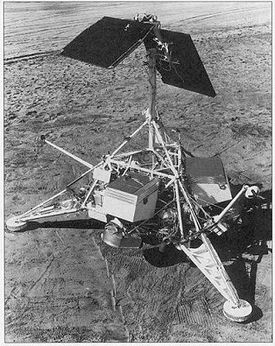 |
http://nssdc.gsfc.nasa.gov/nmc/spacecraftDisplay.do?id=1966-045A | |
| Explorer 33 Explorer 33 Explorer 33 was a spacecraft launched by NASA on July 1, 1966 on a mission of scientific exploration. Originally intended for a lunar orbit, mission controllers worried that the spacecraft's trajectory was too fast to guarantee lunar capture... |
 NASA NASANASA The National Aeronautics and Space Administration is the agency of the United States government that is responsible for the nation's civilian space program and for aeronautics and aerospace research... |
1 July 1966 – 15 September 1971 |
orbiter | partial success | studied interplanetary plasma, cosmic rays, magnetic fields and solar X rays; failed to attain lunar orbit as intended, but achieved mission objectives from Earth orbit |  |
http://nssdc.gsfc.nasa.gov/nmc/spacecraftDisplay.do?id=1966-058A | |
| Lunar Orbiter 1 Lunar Orbiter 1 The Lunar Orbiter 1 robotic spacecraft, part of the Lunar Orbiter Program, was designed primarily to photograph smooth areas of the lunar surface for selection and verification of safe landing sites for the Surveyor and Apollo missions... |
 NASA NASANASA The National Aeronautics and Space Administration is the agency of the United States government that is responsible for the nation's civilian space program and for aeronautics and aerospace research... |
14 August 1966 – 29 October 1966 |
orbiter | success | photographic mapping of lunar surface; intentionally impacted after completion of mission | .jpg) |
http://nssdc.gsfc.nasa.gov/nmc/spacecraftDisplay.do?id=1966-073A | |
| Luna 11 Luna 11 Luna 11 was an unmanned space mission of the Soviet Union's Luna program. It is also called Lunik 11.Luna 11 was launched towards the Moon from an earth-orbiting platform and entered lunar orbit on 27 August 1966... |
 USSR USSR |
28 August 1966 – 1 October 1966 |
orbiter | success | gamma-ray and X-ray-based observations of Moon's composition; gravity, radiation and meteorite studies | http://nssdc.gsfc.nasa.gov/nmc/spacecraftDisplay.do?id=1966-078A | ||
| Surveyor 2 Surveyor 2 Surveyor 2 was to be the second lunar lander in the unmanned American Surveyor program to explore the Moon.It was launched September 20, 1966 from Cape Kennedy, Florida aboard an Atlas-Centaur rocket.... |
 NASA NASANASA The National Aeronautics and Space Administration is the agency of the United States government that is responsible for the nation's civilian space program and for aeronautics and aerospace research... |
23 September 1966 | lander | failure | crashed into Moon |  |
http://nssdc.gsfc.nasa.gov/nmc/spacecraftDisplay.do?id=1966-084A | |
| Luna 12 Luna 12 -External links:*... |
 USSR USSR |
25 October 1966 – 19 January 1967 |
orbiter | success | lunar surface photography | http://nssdc.gsfc.nasa.gov/nmc/spacecraftDisplay.do?id=1966-094A | ||
| Lunar Orbiter 2 Lunar Orbiter 2 The Lunar Orbiter 2 spacecraft was designed primarily to photograph smooth areas of the lunar surface for selection and verification of safe landing sites for the Surveyor and Apollo missions... |
 NASA NASANASA The National Aeronautics and Space Administration is the agency of the United States government that is responsible for the nation's civilian space program and for aeronautics and aerospace research... |
11 October 1967 |
orbiter | success | photographic mapping of lunar surface; intentionally impacted after completion of mission | .jpg) |
http://nssdc.gsfc.nasa.gov/nmc/spacecraftDisplay.do?id=1966-100A | |
| Luna 13 Luna 13 -External links:* *... |
 USSR USSR |
24 December 1966 | lander | success | TV pictures of lunar landscape; soil measurements | 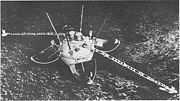 |
http://nssdc.gsfc.nasa.gov/nmc/spacecraftDisplay.do?id=1966-116A | |
1967
| Spacecraft | Organization | Date | Type | Status | Notes | Image | Ref | |
|---|---|---|---|---|---|---|---|---|
| Lunar Orbiter 3 Lunar Orbiter 3 The Lunar Orbiter 3 was a spacecraft launched by NASA in 1967, designed primarily to photograph areas of the lunar surface for confirmation of safe landing sites for the Surveyor and Apollo missions... |
 NASA NASANASA The National Aeronautics and Space Administration is the agency of the United States government that is responsible for the nation's civilian space program and for aeronautics and aerospace research... |
8 February 1967 – 9 October 1967 |
orbiter | success | photographic mapping of lunar surface; intentionally impacted after completion of mission | .jpg) |
http://nssdc.gsfc.nasa.gov/nmc/spacecraftDisplay.do?id=1967-008A | |
| Surveyor 3 Surveyor 3 Surveyor 3 was the third lander of the American unmanned Surveyor program sent to explore the surface of the Moon. Launched on April 17, 1967, Surveyor 3 landed on April 20, 1967 at the Mare Cognitum portion of the Oceanus Procellarum... |
 NASA NASANASA The National Aeronautics and Space Administration is the agency of the United States government that is responsible for the nation's civilian space program and for aeronautics and aerospace research... |
20 April 1967 – 4 May 1967 |
lander | success | various studies, primarily in support of forthcoming manned landings | 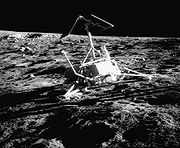 |
http://nssdc.gsfc.nasa.gov/nmc/spacecraftDisplay.do?id=1967-035A | |
| Lunar Orbiter 4 Lunar Orbiter 4 Lunar Orbiter 4 was designed to take advantage of the fact that the three previous Lunar Orbiters had completed the required needs for Apollo mapping and site selection... |
 NASA NASANASA The National Aeronautics and Space Administration is the agency of the United States government that is responsible for the nation's civilian space program and for aeronautics and aerospace research... |
May–October 1967 | orbiter | success | lunar photographic survey | .jpg) |
http://nssdc.gsfc.nasa.gov/nmc/spacecraftDisplay.do?id=1967-041A | |
| Explorer 35 Explorer 35 Explorer 35 was a spin-stabilized spacecraft instrumented for interplanetary studies, at lunar distances, of the interplanetary plasma, magnetic field, energetic particles, and solar X rays. It was launched into an elliptical lunar orbit. The spin axis direction was nearly perpendicular to the... |
 NASA NASANASA The National Aeronautics and Space Administration is the agency of the United States government that is responsible for the nation's civilian space program and for aeronautics and aerospace research... |
July 1967 – 24 June 1973 |
orbiter | success | studies of interplanetary plasma, magnetic fields, energetic particles and solar X rays |  |
http://nssdc.gsfc.nasa.gov/nmc/spacecraftDisplay.do?id=1967-070A | |
| Surveyor 4 Surveyor 4 Surveyor 4 was the fourth lunar lander in the American unmanned Surveyor program sent to explore the surface of the Moon.*Launched July 14, 1967; landed July 17, 1967*Weight on landing: 625 lb... |
 NASA NASANASA The National Aeronautics and Space Administration is the agency of the United States government that is responsible for the nation's civilian space program and for aeronautics and aerospace research... |
17 July 1967 | lander | failure | crashed into Moon |  |
http://nssdc.gsfc.nasa.gov/nmc/spacecraftDisplay.do?id=1967-068A | |
| Lunar Orbiter 5 Lunar Orbiter 5 Lunar Orbiter 5, the last of the Lunar Orbiter series, was designed to take additional Apollo and Surveyor landing site photography and to take broad survey images of unphotographed parts of the Moon's far side... |
 NASA NASANASA The National Aeronautics and Space Administration is the agency of the United States government that is responsible for the nation's civilian space program and for aeronautics and aerospace research... |
5 August 1967 – 31 January 1968 |
orbiter | success | lunar photographic survey; intentionally impacted after completion of mission | .jpg) |
http://nssdc.gsfc.nasa.gov/nmc/spacecraftDisplay.do?id=1967-075A | |
| Surveyor 5 Surveyor 5 Surveyor 5 was the fifth lunar lander of the American unmanned Surveyor program sent to explore the surface of the Moon.*Launched September 8, 1967; landed September 11, 1967*Weight on landing: 303 kg... |
 NASA NASANASA The National Aeronautics and Space Administration is the agency of the United States government that is responsible for the nation's civilian space program and for aeronautics and aerospace research... |
17 December 1967 |
lander | success | various studies, primarily in support of forthcoming manned landings |  |
http://nssdc.gsfc.nasa.gov/nmc/spacecraftDisplay.do?id=1967-084A | |
| Zond 1967A Zond 1967A Soyuz 7K-L1 No.4L, sometimes identified by NASA as Zond 1967A, was a Soviet spacecraft which was launched in 1967 as part of the Zond programme. It was a Soyuz 7K-L1 spacecraft, the first of nine to be launched... † |
 USSR USSR |
28 September 1967 | failure | lunar capsule test flight; launch failure |  |
http://nssdc.gsfc.nasa.gov/planetary/tent_launch.html | ||
| Surveyor 6 Surveyor 6 Surveyor 6 was the sixth lunar lander of the American unmanned Surveyor program that reached the surface of the Moon.*Launched November 7, 1967; landed November 10, 1967*Mass on landing: 299.6 kg Surveyor 6 landed on the Sinus Medii... |
 NASA NASANASA The National Aeronautics and Space Administration is the agency of the United States government that is responsible for the nation's civilian space program and for aeronautics and aerospace research... |
10 November 1967 – 14 December 1967 |
lander | success | various studies, primarily in support of forthcoming manned landings |  |
http://nssdc.gsfc.nasa.gov/nmc/spacecraftDisplay.do?id=1967-112A | |
| Zond 1967B Zond 1967B Soyuz 7K-L1 No.5L, sometimes identified by NASA as Zond 1967B, was a Soviet spacecraft which was launched in 1967 as part of the Zond programme. It was a Soyuz 7K-L1 spacecraft, the second of nine to be launched... † |
 USSR USSR |
22 November 1967 | failure | lunar capsule test flight; launch failure |  |
http://nssdc.gsfc.nasa.gov/planetary/tent_launch.html | ||
1968
| Spacecraft | Organization | Date | Type | Status | Notes | Image | Ref | |
|---|---|---|---|---|---|---|---|---|
| Surveyor 7 Surveyor 7 Surveyor 7 was the seventh and last lunar lander of the American unmanned Surveyor program sent to explore the surface of the Moon.*Launched January 7, 1968; landed January 10, 1968*Weight on landing: 305.7 kg... |
 NASA NASANASA The National Aeronautics and Space Administration is the agency of the United States government that is responsible for the nation's civilian space program and for aeronautics and aerospace research... |
10 January 1968 – 21 February 1968 |
lander | success | various studies, primarily in support of forthcoming manned landings; fifth and final Surveyor mission to achieve soft landing |  |
http://nssdc.gsfc.nasa.gov/nmc/spacecraftDisplay.do?id=1968-001A | |
| Luna 1968A Luna 1968A Luna E-6LS No.112, sometimes identified by NASA as Luna 1968A, was a Soviet spacecraft which was lost in a launch failure in 1968. It was a Luna E-6LS spacecraft, the second of three to be launched... † |
 USSR USSR |
7 February 1968 | orbiter? | failure | failed to reach Earth orbit | http://nssdc.gsfc.nasa.gov/planetary/tent_launch.html | ||
| Zond 4 Zond 4 Zond 4, a formal component of the Soviet Zond program and unmanned version of Soyuz 7K-L1 manned Moon-flyby spacecraft, was one of the first Soviet experiments towards manned circumlunar spaceflight. It was launched to test the spaceworthiness of the new capsule and to gather data about flights in... |
 USSR USSR |
2 March 1968 (launch) | lunar programme flight test, directed away from Moon, either intentionally or unintentionally |  |
http://nssdc.gsfc.nasa.gov/nmc/spacecraftDisplay.do?id=1968-013A | |||
| Luna 14 Luna 14 -External links:*... |
 USSR USSR |
10 April 1968 – ? | orbiter | success | tests of radio communications technologies; lunar mascon studies | http://nssdc.gsfc.nasa.gov/nmc/spacecraftDisplay.do?id=1968-027A | ||
| Zond 1968A† |  USSR USSR |
23 April 1968 | flyby? | failure | launch failure |  |
http://nssdc.gsfc.nasa.gov/planetary/tent_launch.html | |
| Zond 5 Zond 5 Zond 5, a formal member of the Soviet Zond program and unmanned version of Soyuz 7K-L1 manned moon-flyby spacecraft, was launched from a Tyazheliy Sputnik in Earth parking orbit to make scientific studies during a lunar flyby and to return to Earth.... |
 USSR USSR |
18 September 1968 | flyby | success | bioscience experiments; returned to soft landing on Earth |  |
http://nssdc.gsfc.nasa.gov/nmc/spacecraftDisplay.do?id=1968-076A | |
| Zond 6 Zond 6 Zond 6, a formal member of the Soviet Zond program and unmanned version of Soyuz 7K-L1 manned moon-flyby spacecraft, was launched on a lunar flyby mission from a parent satellite in Earth parking orbit... |
 USSR USSR |
14 November 1968 | flyby | success | cosmic-ray, micrometeoroid and bioscience studies; returned to soft landing on Earth |  |
http://nssdc.gsfc.nasa.gov/nmc/spacecraftDisplay.do?id=1968-101A | |
1969
| Spacecraft | Organization | Date | Type | Status | Notes | Image | Ref | |
|---|---|---|---|---|---|---|---|---|
| Zond 1969A† |  USSR USSR |
20 January 1969 | flyby | failure | launch aborted |  |
http://nssdc.gsfc.nasa.gov/planetary/tent_launch.html | |
| Luna 1969A Luna 1969A Luna E-8 No.201, also known as Luna Ye-8 No.201, and sometimes identified by NASA as Luna 1969A, was a Soviet spacecraft which was lost in a launch failure in 1969. It was a Luna E-8 spacecraft, the first of three to be launched, It was intended to perform a soft landing on the Moon, in order to... † |
 USSR USSR |
19 February 1969 | rover | failure | launch vehicle failure |  |
http://nssdc.gsfc.nasa.gov/planetary/tent_launch.html | |
| Zond L1S-1† |  USSR USSR |
21 February 1969 | orbiter | failure | launch vehicle failure |  |
http://nssdc.gsfc.nasa.gov/planetary/tent_launch.html | |
| Luna 1969B† |  USSR USSR |
15 April 1969 | sample return? | failure | launch failure | 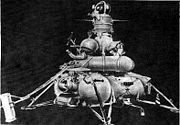 |
http://nssdc.gsfc.nasa.gov/planetary/tent_launch.html | |
| Luna 1969C Luna 1969C Luna E-8-5 No.402, also known as Luna Ye-8-5 No.402, and sometimes identified by NASA as Luna 1969C, was a Soviet spacecraft which was lost in a launch failure in 1969. It was a Luna E-8-5 spacecraft, the first of eight to be launched. It was intended to perform a soft landing on the Moon, collect... † |
 USSR USSR |
14 June 1969 | sample return | failure | launch failure |  |
http://nssdc.gsfc.nasa.gov/planetary/tent_launch.html | |
| Zond L1S-2† |  USSR USSR |
3 July 1969 | orbiter | failure | launch failure |  |
http://nssdc.gsfc.nasa.gov/planetary/tent_launch.html | |
| Luna 15 Luna 15 -External links:*... |
 USSR USSR |
21 July 1969 | failure? | completed 52 lunar orbits then crash-landed |  |
http://nssdc.gsfc.nasa.gov/nmc/spacecraftDisplay.do?id=1969-058A | ||
| Zond 7 Zond 7 This article was originally based on material from ... |
 USSR USSR |
11 August 1969 | flyby | success | returned to soft landing on Earth |  |
http://nssdc.gsfc.nasa.gov/nmc/spacecraftDisplay.do?id=1969-067A | |
| Cosmos 300 Cosmos 300 Kosmos 300 was the fourth Soviet attempt at an unmanned lunar sample return. It was probably similar in design to the later Luna 16 spacecraft. It was launched, on a Proton rocket, on September 23, 1969. The mission was a failure. The engines on the Block D upper stage failed, leaving the... |
 USSR USSR |
23 September 1969 | sample return | failure | failed to escape Earth orbit |  |
http://nssdc.gsfc.nasa.gov/nmc/spacecraftDisplay.do?id=1969-080A | |
| Cosmos 305 Cosmos 305 Kosmos 305 was the fifth Soviet attempt at an unmanned lunar sample return. It was probably similar in design to the Luna 16 spacecraft. It was launched, on a Proton rocket, on October 22, 1969. The engines on the Block D upper stage failed, terminating the mission. This left the spacecraft... |
 USSR USSR |
22 October 1969 | sample return | failure | failed to escape Earth orbit |  |
http://nssdc.gsfc.nasa.gov/nmc/spacecraftDisplay.do?id=1969-092A | |
1970
| Spacecraft | Organization | Date | Type | Status | Notes | Image | Ref | |
|---|---|---|---|---|---|---|---|---|
| Luna 1970A Luna 1970A Luna E-8-5 No.405, also known as Luna Ye-8-5 No.405, and sometimes identified by NASA as Luna 1970A, was a Soviet spacecraft which was lost in a launch failure in 1970. It was a Luna E-8-5 spacecraft, the fifth of eight to be launched... † |
 USSR USSR |
6 February 1970 | sample return? | failure | launch vehicle failure |  |
http://nssdc.gsfc.nasa.gov/planetary/tent_launch.html | |
| Luna 1970B† |  USSR USSR |
19 February 1970 | orbiter? | failure | launch vehicle failure | 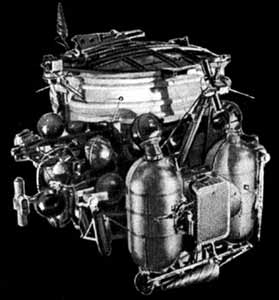 |
http://nssdc.gsfc.nasa.gov/planetary/tent_launch.html | |
| Luna 16 Luna 16 -External links:*... |
 USSR USSR |
20 September 1970 | sample return | success | first robotic sample return |  |
http://nssdc.gsfc.nasa.gov/nmc/spacecraftDisplay.do?id=1970-072A | |
| Zond 8 |  USSR USSR |
24 October 1970 | flyby | success | returned to soft landing on Earth |  |
http://nssdc.gsfc.nasa.gov/nmc/spacecraftDisplay.do?id=1970-088A | |
| Luna 17 Luna 17 -External links:*... |
 USSR USSR |
17 November 1970 – 4 October 1971 |
lander | success | deployed rover |  |
http://nssdc.gsfc.nasa.gov/nmc/spacecraftDisplay.do?id=1970-095A | |
| Lunokhod 1 Lunokhod 1 Lunokhod 1 was the first of two unmanned lunar rovers landed on the Moon by the Soviet Union as part of its Lunokhod program. The spacecraft which carried Lunokhod 1 was named Luna 17... |
rover | success | first robotic rover; travelled over 10 km |  |
||||
1971–1983
| Spacecraft | Organization | Date | Type | Status | Notes | Image | Ref | |
|---|---|---|---|---|---|---|---|---|
| Luna 18 Luna 18 Luna 18 was an unmanned space mission of the Luna program, also called Lunik 18.Luna 18 was placed in an earth parking orbit after it was launched and was then sent towards the Moon. On September 7, 1971, it entered lunar orbit. The spacecraft completed 85 communications sessions and 54 lunar... |
 USSR USSR |
11 September 1971 | lander/sample return? | failure | crashed into Moon |  |
http://nssdc.gsfc.nasa.gov/nmc/spacecraftDisplay.do?id=1971-073A | |
| Luna 19 Luna 19 Luna 19 , was an unmanned space mission of the Luna program. Luna 19 extended the systematic study of lunar gravitational fields and location of mascons . It also studied the lunar radiation environment, the gamma-active lunar surface, and the solar wind... |
 USSR USSR |
3 October 1971 – October 1972 |
orbiter | success |  |
http://nssdc.gsfc.nasa.gov/nmc/spacecraftDisplay.do?id=1971-082A | ||
| Luna 20 Luna 20 Luna 20 was the second of three successful Soviet lunar sample return missions. It was flown as part of the Luna program, also called Lunik 20, as a robotic competitor to the six successful Apollo lunar sample return missions.... |
 USSR USSR |
21 February 1972 | sample return | success | second successful robotic sample return |  |
http://nssdc.gsfc.nasa.gov/nmc/spacecraftDisplay.do?id=1972-007A | |
| Soyuz L3† |  USSR USSR |
23 November 1972 | orbiter | failure | launch failure | 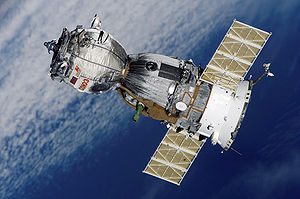 |
http://nssdc.gsfc.nasa.gov/planetary/tent_launch.html | |
| Luna 21 Luna 21 -External links:*... |
 USSR USSR |
15 January 1973 – May 1973? |
lander | success | deployed rover |  |
http://nssdc.gsfc.nasa.gov/nmc/spacecraftDisplay.do?id=1973-001A | |
| Lunokhod 2 Lunokhod 2 Lunokhod 2 was the second of two unmanned lunar rovers landed on the Moon by the Soviet Union as part of the Lunokhod program.... |
rover | success | second robotic rover; travelled 37 km |  |
||||
| Explorer 49 Explorer 49 Explorer 49 was a 328 kilogram satellite launched on June 10, 1973 for longwave radio astronomy research. It had four 230-meter long X-shaped antenna elements, which made it one of the largest spacecraft ever built.... |
 NASA NASANASA The National Aeronautics and Space Administration is the agency of the United States government that is responsible for the nation's civilian space program and for aeronautics and aerospace research... |
15 June 1973 – June 1975 |
orbiter | success | radio astronomy observations; last US lunar mission until 1994 |  |
http://nssdc.gsfc.nasa.gov/nmc/spacecraftDisplay.do?id=1973-039A | |
| Mariner 10 Mariner 10 Mariner 10 was an American robotic space probe launched by NASA on November 3, 1973, to fly by the planets Mercury and Venus. It was launched approximately two years after Mariner 9 and was the last spacecraft in the Mariner program... |
 NASA NASANASA The National Aeronautics and Space Administration is the agency of the United States government that is responsible for the nation's civilian space program and for aeronautics and aerospace research... |
November 1973 | flyby | success | en route to Venus and Mercury | 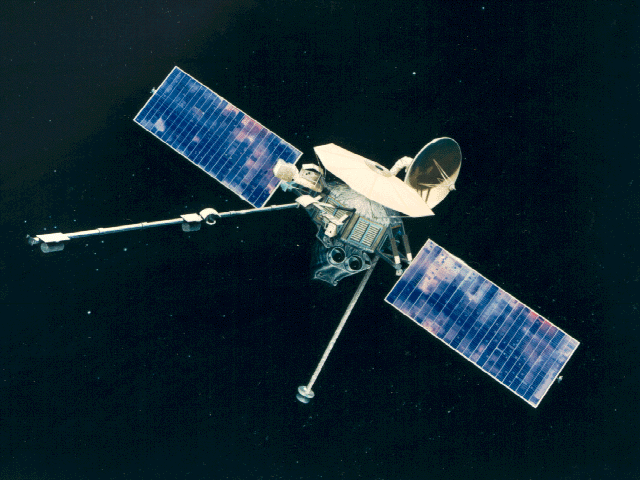 |
||
| Luna 22 Luna 22 Luna 22 was an unmanned space mission, part of the Soviet Luna program, also called Lunik 22.Luna 22 was a lunar orbiter mission... |
 USSR USSR |
2 June 1974 – November 1974 |
orbiter | success |  |
http://nssdc.gsfc.nasa.gov/nmc/spacecraftDisplay.do?id=1974-037A | ||
| Luna 23 Luna 23 Luna 23 was an unmanned space mission of the Luna program, also called Lunik 23.Luna 23 was a Moon lander mission which was intended to return a lunar sample to Earth. Launched to the Moon by a Proton SL-12/D-1-e booster, the spacecraft was damaged during landing in Mare Crisium... |
 USSR USSR |
6 November 1974 | sample return | failure | damaged on landing, sample return failed | http://nssdc.gsfc.nasa.gov/nmc/spacecraftDisplay.do?id=1974-084A | ||
| Luna 1975A Luna 1975A Luna E-8-5M No.412, also known as Luna Ye-8-5M No.412, and sometimes identified by NASA as Luna 1975A, was a Soviet spacecraft which was lost in a launch failure in 1975. It was a Luna E-8-5M spacecraft, the second of three to be launched... † |
 USSR USSR |
16 October 1975 | sample return | failure | failed to reach Earth orbit | http://nssdc.gsfc.nasa.gov/planetary/tent_launch.html | ||
| Luna 24 Luna 24 -External links:*... |
 USSR USSR |
18 August 1976 | sample return | success | third and final successful sample return in Luna programme | http://nssdc.gsfc.nasa.gov/nmc/spacecraftDisplay.do?id=1976-081A | ||
| ICE International Cometary Explorer The International Cometary Explorer spacecraft was originally known as International Sun/Earth Explorer 3 satellite, launched August 12, 1978. It was part of the ISEE international cooperative program between NASA and ESRO/ESA to study the interaction between the Earth's magnetic field and the... (formerly ISEE3) |
 NASA NASANASA The National Aeronautics and Space Administration is the agency of the United States government that is responsible for the nation's civilian space program and for aeronautics and aerospace research... |
22 December 1983 | flyby | success | gravity assist en route to comet flybys |  |
http://nssdc.gsfc.nasa.gov/nmc/spacecraftDisplay.do?id=1978-079A | |
1990–1999
| Spacecraft | Organization | Date | Type | Status | Notes | Image | Ref | |
|---|---|---|---|---|---|---|---|---|
| Hiten Hiten The Hiten Spacecraft , given the English name Celestial Maiden and known before launch as MUSES-A , part of the MUSES Program, was built by the Institute of Space and Astronautical Science of Japan and launched on January 24, 1990... |
 ISAS ISASInstitute of Space and Astronautical Science is a Japanese national research organization of astrophysics using rockets, astronomical satellites and interplanetary probes. It is a division of Japan Aerospace Exploration Agency .- History :... |
March 1990 – October 1991 | flyby (approached 10 times) | success | in Moon-crossing Earth orbit from January 1990, later transferred to lunar orbit after failure of Hagoromo; intentionally impacted on Moon at end of mission; first Japanese probe to enter lunar orbit |  |
http://nssdc.gsfc.nasa.gov/nmc/spacecraftDisplay.do?id=1990-007A | |
| February 1992 – April 1993 | orbiter | success | ||||||
| Hagoromo Hiten The Hiten Spacecraft , given the English name Celestial Maiden and known before launch as MUSES-A , part of the MUSES Program, was built by the Institute of Space and Astronautical Science of Japan and launched on January 24, 1990... |
 ISAS ISASInstitute of Space and Astronautical Science is a Japanese national research organization of astrophysics using rockets, astronomical satellites and interplanetary probes. It is a division of Japan Aerospace Exploration Agency .- History :... |
March 1990 | orbiter | failure | released by Hiten into lunar orbit, but transmitter failed and orbit never confirmed | |||
| GEOTAIL GEOTAIL GEOTAIL is a satellite observing the Earth's magnetosphere. It was developed by ISAS in association with NASA, and launched by a Delta II rocket on July 24, 1992.... |
 ISAS ISASInstitute of Space and Astronautical Science is a Japanese national research organization of astrophysics using rockets, astronomical satellites and interplanetary probes. It is a division of Japan Aerospace Exploration Agency .- History :... /  NASA NASANASA The National Aeronautics and Space Administration is the agency of the United States government that is responsible for the nation's civilian space program and for aeronautics and aerospace research... |
September 1992 – November 1994 | flyby (approached 14 times) | success | gravity assist en route magnetotail around L2 / finally deployed into high earth orbit | http://www.isas.jaxa.jp/e/enterp/missions/geotail/index.shtml | ||
| Clementine Clementine mission Clementine was a joint space project between the Ballistic Missile Defense Organization and NASA... |
 BMDO BMDOBallistic Missile Defense Organization The Ballistic Missile Defense Organization was an agency of the United States Department of Defense that began on 20 May 1974 with the responsibility for all U.S. ballistic missile defense efforts. It evolved from the SAFEGUARD System Organization. The original mission of BMDO was comparable to... /  NASA NASANASA The National Aeronautics and Space Administration is the agency of the United States government that is responsible for the nation's civilian space program and for aeronautics and aerospace research... |
February – June 1994 | orbiter | partial success | lunar and Earth observations and component testing; planned Geographos 1620 Geographos The asteroid 1620 Geographos was discovered on September 14, 1951 at the Palomar Observatory by Albert George Wilson and Rudolph Minkowski. It was originally given the provisional designation 1951 RA... flyby failed |
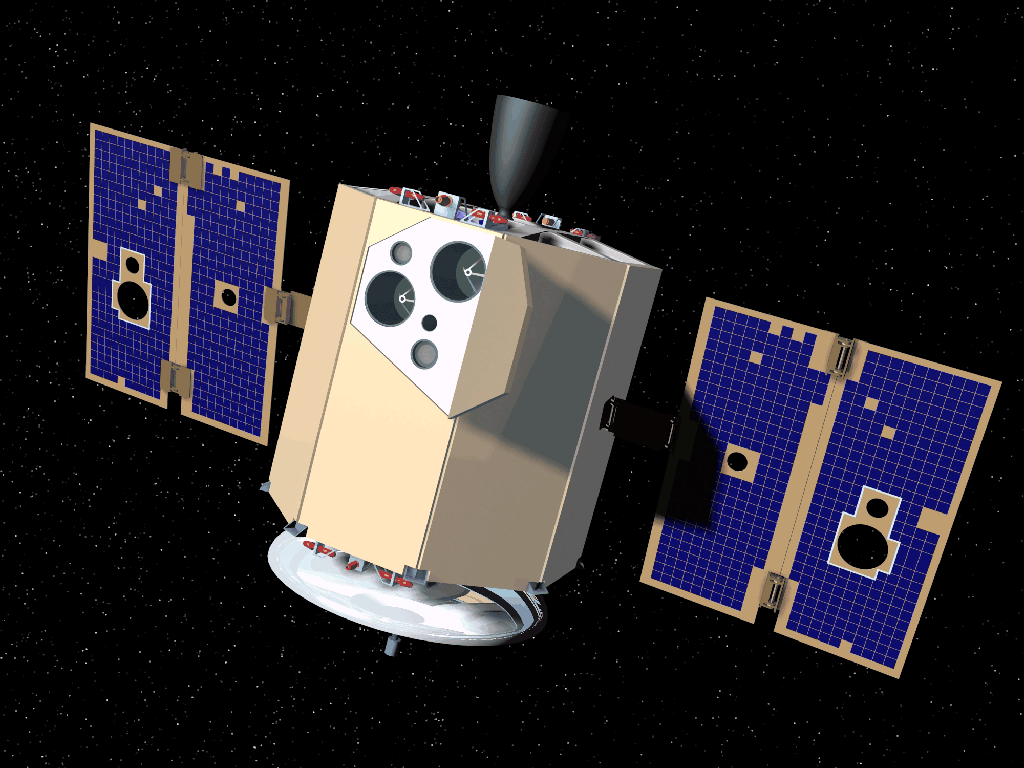 |
http://nssdc.gsfc.nasa.gov/nmc/spacecraftDisplay.do?id=1994-004A | |
| HGS-1 HGS-1 PAS-22, previously known as AsiaSat 3 and then HGS-1, was a geosynchronous communications satellite which was salvaged from an unusable geosynchronous transfer orbit by means of the Moon's gravity.... |
Hughes Global Services | May/June 1998 | errant communications satellite, flew within 6,200 kilometers of Moon during orbit correction manoeuvres | http://nssdc.gsfc.nasa.gov/nmc/spacecraftDisplay.do?id=1997-086A | ||||
| Lunar Prospector Lunar Prospector The Lunar Prospector mission was the third selected by NASA for full development and construction as part of the Discovery Program. At a cost of $62.8 million, the 19-month mission was designed for a low polar orbit investigation of the Moon, including mapping of surface composition and possible... |
 NASA NASANASA The National Aeronautics and Space Administration is the agency of the United States government that is responsible for the nation's civilian space program and for aeronautics and aerospace research... |
January 1998 – July 1999 |
orbiter | success | lunar surface mapping; intentionally impacted into polar crater at end of mission to test for liberation of water vapour (not detected) |  |
http://nssdc.gsfc.nasa.gov/nmc/spacecraftDisplay.do?id=1998-001A | |
| Nozomi |  ISAS ISASInstitute of Space and Astronautical Science is a Japanese national research organization of astrophysics using rockets, astronomical satellites and interplanetary probes. It is a division of Japan Aerospace Exploration Agency .- History :... |
24 September 1998 | flyby | success | gravity assists on planned mission to Mars | 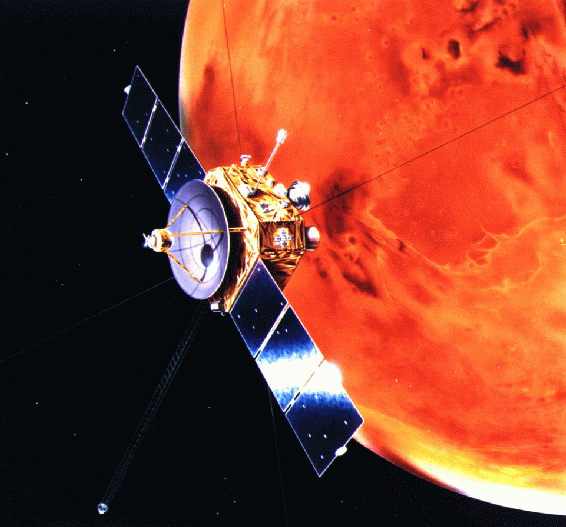 |
http://nssdc.gsfc.nasa.gov/nmc/spacecraftDisplay.do?id=1998-041A | |
| 18 December 1998 | flyby | success | ||||||
2000-present
| Spacecraft | Organization | Date | Type | Status | Notes | Image | Ref | |
|---|---|---|---|---|---|---|---|---|
| SMART-1 SMART-1 SMART-1 was a Swedish-designed European Space Agency satellite that orbited around the Moon. It was launched on September 27, 2003 at 23:14 UTC from the Guiana Space Centre in Kourou, French Guiana. "SMART" stands for Small Missions for Advanced Research in Technology... |
 ESA ESAEuropean Space Agency The European Space Agency , established in 1975, is an intergovernmental organisation dedicated to the exploration of space, currently with 18 member states... |
13 November 2004 – 3 September 2006 |
orbiter | success | technology testbed and lunar geological studies; intentionally impacted at end of mission; first European probe to orbit the Moon | http://nssdc.gsfc.nasa.gov/nmc/spacecraftDisplay.do?id=2003-043C | ||
| SELENE SELENE SELENE , better known in Japan by its nickname after the legendary Japanese moon princess, was the second Japanese lunar orbiter spacecraft. Produced by the Institute of Space and Astronautical Science and the National Space Development Agency , both now part of the Japan Aerospace Exploration... (Kaguya) |
 JAXA JAXA |
3 October 2007 – 10 June 2009 | orbiter | success | mineralogical, geographical, magnetic and gravitational observations |  |
http://nssdc.gsfc.nasa.gov/nmc/spacecraftDisplay.do?id=2007-039A | |
| Okina (Relay Star) |
 JAXA JAXA |
9 October 2007 – 12 February 2009 | Kaguya subsatellite | success | relay for Kaguyas Far Side operations | |||
| Ouna (VRAD) |
 JAXA JAXA |
12 October 2007 – 29 June 2009 | Kaguya subsatellite | success (still in orbit) | Very Long Baseline Interferometry Very Long Baseline Interferometry Very Long Baseline Interferometry is a type of astronomical interferometry used in radio astronomy. It allows observations of an object that are made simultaneously by many telescopes to be combined, emulating a telescope with a size equal to the maximum separation between the telescopes.Data... |
|||
| Chang'e 1 |  CNSA CNSAChina National Space Administration The China National Space Administration is the national space agency of the People's Republic of China responsible for the national space program. It is responsible for planning and development of space activities... |
5 November 2007 – 1 March 2009 | orbiter | success | 3D lunar mapping and geological observations; first Chinese probe to orbit a body besides Earth |  |
http://nssdc.gsfc.nasa.gov/nmc/spacecraftDisplay.do?id=CHANG-E-1 | |
| Chandrayaan I |  ISRO ISROIndian Space Research Organisation The Indian Space Research Organisation is an independent Indian governmental agency established in 1969 for the research and development of vehicles and activities for the exploration of space within and outside of Earth’s atmosphere. Headquartered in Bangalore... |
8 November 2008 – 29 August 2009 | orbiter | partial success (still in orbit) | high resolution three-dimensional mapping and spectral analysis of the Moon's surface and inner compositions |  |
http://www.isro.org/Chandrayaan/htmls/home.htm | |
| Moon Impact Probe (MIP) Moon Impact Probe The Moon Impact Probe developed by the Indian Space Research Organisation , India's national space agency, was a lunar probe that was released by ISRO's Chandrayaan-1 lunar remote sensing orbiter which in turn was launched, on 22 October 2008, aboard a modified version of ISRO's Polar Satellite... |
 ISRO ISROIndian Space Research Organisation The Indian Space Research Organisation is an independent Indian governmental agency established in 1969 for the research and development of vehicles and activities for the exploration of space within and outside of Earth’s atmosphere. Headquartered in Bangalore... |
14 November 2008 | impactor | successful | test and demonstrate targeting technologies in anticipation of future soft landings, scientific observation of the Moon from close range | http://www.isro.gov.in/Chandrayaan/htmls/mip.htm | ||
| Lunar Reconnaissance Orbiter Lunar Reconnaissance Orbiter The Lunar Precursor Robotic Program is a program of robotic spacecraft missions which NASA will use to prepare for future human spaceflight missions to the Moon. Two LPRP missions, the Lunar Reconnaissance Orbiter and the Lunar Crater Observation and Sensing Satellite , were launched in June 2009... |
 NASA NASANASA The National Aeronautics and Space Administration is the agency of the United States government that is responsible for the nation's civilian space program and for aeronautics and aerospace research... |
23 June 2009 – | orbiter | in orbit | survey of lunar resources and identification of possible landing sites | 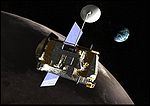 |
http://nssdc.gsfc.nasa.gov/nmc/spacecraftDisplay.do?id=LUNARRO | |
| LCROSS LCROSS The Lunar Crater Observation and Sensing Satellite was a robotic spacecraft operated by NASA. The mission was conceived as a low-cost means of determining the nature of hydrogen detected at the polar regions of the moon. The main LCROSS mission objective was to explore the presence of water ice... |
9 October 2009 | impactor | success | analyzed upper-stage impact plume for traces of water liberated from the Moon's surface |  |
http://lcross.arc.nasa.gov/ | ||
| Chang'e 2 Chang'e 2 Chang'e 2 is a Chinese unmanned lunar probe that was launched on 1 October 2010. It was a follow-up to the Chang'e 1 lunar probe, which was launched in 2007. Chang'e 2 was part of the first phase of the Chinese Lunar Exploration Program, and conducted research from a 100-kilometer-high lunar orbit... |
 CNSA CNSAChina National Space Administration The China National Space Administration is the national space agency of the People's Republic of China responsible for the national space program. It is responsible for planning and development of space activities... |
1 October 2010 – 27 August 2011 | orbiter | success | capture high resolution images of soft landing site for Chang'e 3, measure and analyze content of the surface | http://news.xinhuanet.com/english/2006-07/26/content_4878282.htm | ||
| ARTEMIS P1 Themis Themis is an ancient Greek Titaness. She is described as "of good counsel", and is the embodiment of divine order, law, and custom. Themis means "divine law" rather than human ordinance, literally "that which is put in place", from the verb τίθημι, títhēmi, "to put"... |
 NASA NASANASA The National Aeronautics and Space Administration is the agency of the United States government that is responsible for the nation's civilian space program and for aeronautics and aerospace research... |
April 2011 | orbiter | in orbit as of July 2, 2011 | to study the effect of the solar wind on the lunar surface | http://www.space.com/scienceastronomy/nasa-spacecraft-artemis-moon-mission-101028.html | ||
| ARTEMIS P2 Themis Themis is an ancient Greek Titaness. She is described as "of good counsel", and is the embodiment of divine order, law, and custom. Themis means "divine law" rather than human ordinance, literally "that which is put in place", from the verb τίθημι, títhēmi, "to put"... |
 NASA NASANASA The National Aeronautics and Space Administration is the agency of the United States government that is responsible for the nation's civilian space program and for aeronautics and aerospace research... |
April 2011 | orbiter | in orbit as of July 17, 2011 | to study the effect of the solar wind on the lunar surface | http://www.space.com/scienceastronomy/nasa-spacecraft-artemis-moon-mission-101028.html | ||
| GRAIL Gravity Recovery and Interior Laboratory The Gravity Recovery and Interior Laboratory is an American lunar science mission in NASA's Discovery Program, which will use high-quality gravitational field mapping of the Moon to determine its interior structure... |
 NASA NASANASA The National Aeronautics and Space Administration is the agency of the United States government that is responsible for the nation's civilian space program and for aeronautics and aerospace research... |
September 10, 2011 | orbiter | in transit | Mapping the Moon's gravitational field. | http://science.nasa.gov/missions/grail/ | ||
Future
| Spacecraft | Organization | Date | Type | Status | Notes | Image | Ref | |
|---|---|---|---|---|---|---|---|---|
| LADEE Lunar Atmosphere and Dust Environment Explorer The Lunar Atmosphere and Dust Environment Explorer is a space exploration mission scheduled for launch in early 2013. To carry out the mission NASA will send a robotic spacecraft into orbit around the Moon, and use instruments aboard the spacecraft to study the Moon's atmosphere and dust in the... |
 NASA NASANASA The National Aeronautics and Space Administration is the agency of the United States government that is responsible for the nation's civilian space program and for aeronautics and aerospace research... |
January 15, 2013 | orbiter | under development | orbiter | http://nssdc.gsfc.nasa.gov/nmc/spacecraftDisplay.do?id=LADEE | ||
| GLXP Google Lunar X Prize The Google Lunar X PRIZE, abbreviated GLXP, sometimes referred to as Moon 2.0, is a space competition organized by the X Prize Foundation, and sponsored by Google. It was announced at the Wired Nextfest on 13 September 2007... Moon Express Moon Express Moon Express, or MoonEx, is a privately held seed-stage company formed by a group of Silicon Valley and space entrepreneurs, with the goal of winning the Google Lunar X Prize, and ultimately mining the Moon for resources of economic value.-History:... |
Private Private spaceflight Private spaceflight is flight above Earth altitude conducted by and paid for by an entity other than a government. In the early decades of the Space Age, the government space agencies of the Soviet Union and United States pioneered space technology augmented by collaboration with affiliated design... |
2013 | lander | under development | lander | http://www.moonexpress.com/ | ||
| GLXP Google Lunar X Prize The Google Lunar X PRIZE, abbreviated GLXP, sometimes referred to as Moon 2.0, is a space competition organized by the X Prize Foundation, and sponsored by Google. It was announced at the Wired Nextfest on 13 September 2007... Astrobotic Technology Astrobotic Technology Astrobotic Technology is a privately held seed-stage company formed by Carnegie Mellon professor Red Whittaker and his associates, with the goal of winning the Google Lunar X Prize... |
Private Private spaceflight Private spaceflight is flight above Earth altitude conducted by and paid for by an entity other than a government. In the early decades of the Space Age, the government space agencies of the Soviet Union and United States pioneered space technology augmented by collaboration with affiliated design... |
December 2013 | lander | under development | lander | http://astrobotic.net/activities/tranquility-trek/ | ||
| Chang'e 3 Chang'e 3 Chang'e 3 is a Chinese lunar exploration mission, incorporating a robotic lander and rover. Scheduled for launch in 2013 as part of the second phase of the Chinese Lunar Exploration Program, it will be China's first lunar rover, and the first spacecraft to make a soft landing on the Moon since the... |
 CNSA CNSAChina National Space Administration The China National Space Administration is the national space agency of the People's Republic of China responsible for the national space program. It is responsible for planning and development of space activities... |
2013 | orbiter | under development | soft lander | http://news.xinhuanet.com/english/2006-07/26/content_4878282.htm | ||
| lander/rover | ||||||||
| Chandrayaan II with Luna-Resurs |  ISRO ISROIndian Space Research Organisation The Indian Space Research Organisation is an independent Indian governmental agency established in 1969 for the research and development of vehicles and activities for the exploration of space within and outside of Earth’s atmosphere. Headquartered in Bangalore... /  Russian Federal Space Agency Russian Federal Space AgencyRussian Federal Space Agency The Russian Federal Space Agency , commonly called Roscosmos and abbreviated as FKA and RKA , is the government agency responsible for the Russian space science program and general aerospace research. It was previously the Russian Aviation and Space Agency .Headquarters of Roscosmos are located... |
2013 | orbiter | under development | relaying date from the Chandrayaan II lunar rover, imaging and searching for deposits of helium-3 Helium-3 Helium-3 is a light, non-radioactive isotope of helium with two protons and one neutron. It is rare on Earth, and is sought for use in nuclear fusion research... and ice Lunar ice Lunar water is water that is present on the Moon. Liquid water cannot persist at the Moon's surface, and water vapour is quickly decomposed by sunlight and lost to outer space... on the surface of the Moon. |
http://www.newkerala.com/topstory-fullnews-35387.html http://www.russianspaceweb.com/luna_resurs.html | ||
| lander/rover | ||||||||
| MoonRise MoonRise The MoonRise mission focuses on the giant South Pole-Aitken Basin on the far side of the moon between the Moon's South Pole and Aitken Crater, 16° south of the Moon's equator. This basin measures nearly in diameter and in depth... |
 NASA NASANASA The National Aeronautics and Space Administration is the agency of the United States government that is responsible for the nation's civilian space program and for aeronautics and aerospace research... |
October 2016 | lander | under development | sample return to Earth | http://moonrise.jpl.nasa.gov/ | ||
| Chang'e 4 Chinese Lunar Exploration Program Chinese Lunar Exploration Program , also known as the Chang'e program, is a program of robotic and human missions to the Moon undertaken by the China National Space Administration , the space agency of the People's Republic of China... |
 CNSA CNSAChina National Space Administration The China National Space Administration is the national space agency of the People's Republic of China responsible for the national space program. It is responsible for planning and development of space activities... |
2017 | orbiter | planned | sample return to Earth | http://news.xinhuanet.com/english/2006-07/26/content_4878282.htm | ||
| sample return | ||||||||
See also
- Landings on other planetsLandings on other planetsThis is a list of all spacecraft landings on other planets and bodies in the solar system, including soft landings and both intended and unintended hard impacts...
- List of Solar System probes
- Robotic spacecraftRobotic spacecraftA robotic spacecraft is a spacecraft with no humans on board, that is usually under telerobotic control. A robotic spacecraft designed to make scientific research measurements is often called a space probe. Many space missions are more suited to telerobotic rather than crewed operation, due to...
- Timeline of Solar System explorationTimeline of solar system explorationThis is a timeline of Solar System exploration ordered by date of spacecraft launch. It includes:*All spacecraft that have left Earth orbit for the purposes of Solar System exploration , including lunar probes....
- List of current and future lunar missions

